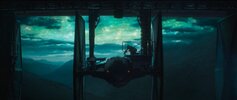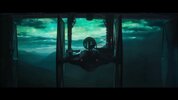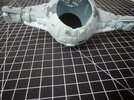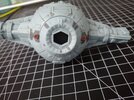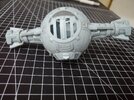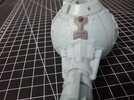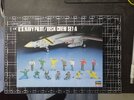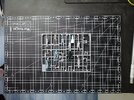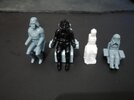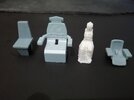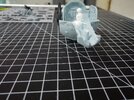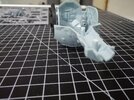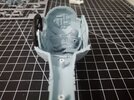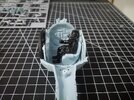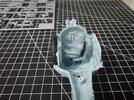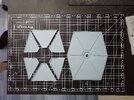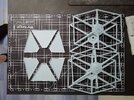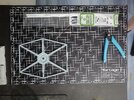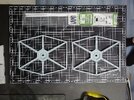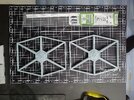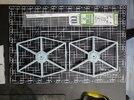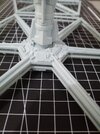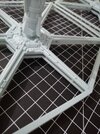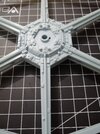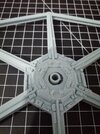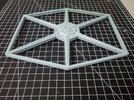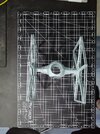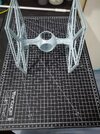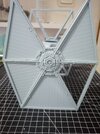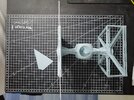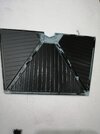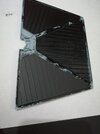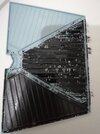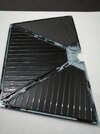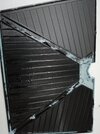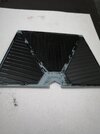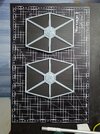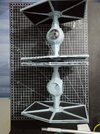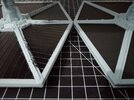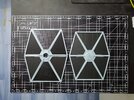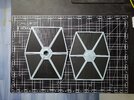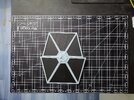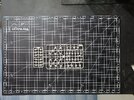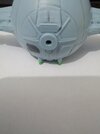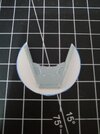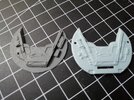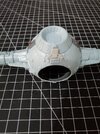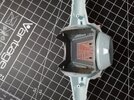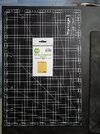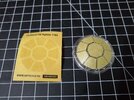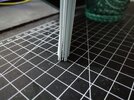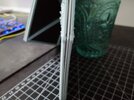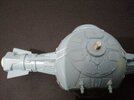Rulebreaker
Active Member
Hello,
i bought this Revell "1/65" Outland Tie Fighter. It was/is on sale on amazon for only 15 Bucks
For 15 Bucks its a great kit, and i can live with the wrong details here and there.
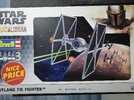
1 Scale Discussion
this is a comparison i found online, i modified it and added more information to it
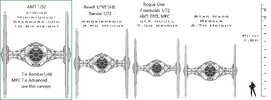
so there are three main series
The "108", the "88" and the "75" series, but the pilot is always the same size, regardless of the "series believs"
In my observation the "108" series is correct, because the pilot has a good look trough the viewport. In "75" it looks straight into the fuselage, so no chances to see anything, where the "88" series offers a view trough the upper part of the viewport(wich opens the discussion about turning the viewport)
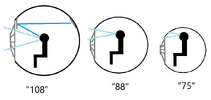
not to scale, but u should get the idea, i tried making pictures but i cant get em sharp enough to lets you see something
the "108" also gives the pilot the chance to look up in the mirror, to see whats behind him on the screen
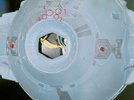
I think 1 shows the rear faceing camera, 2 is the chaf dispenser, 3 is the flare dispencer and 4 looks like a ircm
I think scaleing around the viewport is good, but can get improved when taking the pilot too. On the most "planes" it doesnt mather much if its "108" or "88" but on the tie bomber, the pilot cant sit straight
* Finemolds made a beautifuler cockpit compared to the usual vanila thing, but the pilot looks too big - or the "plane" is to small
* Bandai tried to put the pilot lower, reminds me about the/this millenium falcon shot
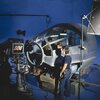
* AMT tried to make the pilot sit lower in a lovely beach chair where you can put your legs in the air and relax
* Revel doesnt even care, they put a 1/40 Pilot in, who is directly looking into the fuselage
i found a rebel pilot in 1/48 on thingy, i made a couple of "view checks" - looks great, but i also ordered a Hasegawa Ground crew in 1/48
2 Unboxing

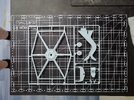
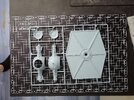
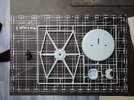
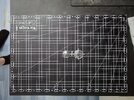
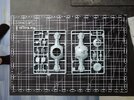

some sprues are doubled
a whole Tie Fighter was/is included and some retrofit parts for the new Outland Tie Fighter
a small comparison with the AMT Tie Intercepter from "75" series

AMTs 1/32 is from the "108" series, but i could not find a shop in europe(not england) that has it in stock, or is willing to ship to my country
3 Build



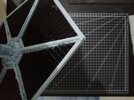
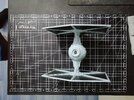

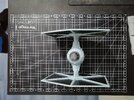

I built and painted it like the instructions says, nothing special, i liked the mold color, so i was only painting the solar panels black, and the cockpit and vieport dark grey/gray.
I tried masking off the wings with tape, but the results were terrible, no mather how good you tape it off, there will always be some clean up needed afterwards.
after painting, the outer wing goes only hardly on, because of the added color on the pins, so either mask the pins of or drill the holes a little wider
4 Retrofit coming soon
need to make pictures first
i bought this Revell "1/65" Outland Tie Fighter. It was/is on sale on amazon for only 15 Bucks
For 15 Bucks its a great kit, and i can live with the wrong details here and there.

1 Scale Discussion
this is a comparison i found online, i modified it and added more information to it

so there are three main series
The "108", the "88" and the "75" series, but the pilot is always the same size, regardless of the "series believs"
In my observation the "108" series is correct, because the pilot has a good look trough the viewport. In "75" it looks straight into the fuselage, so no chances to see anything, where the "88" series offers a view trough the upper part of the viewport(wich opens the discussion about turning the viewport)

not to scale, but u should get the idea, i tried making pictures but i cant get em sharp enough to lets you see something
the "108" also gives the pilot the chance to look up in the mirror, to see whats behind him on the screen

I think 1 shows the rear faceing camera, 2 is the chaf dispenser, 3 is the flare dispencer and 4 looks like a ircm
I think scaleing around the viewport is good, but can get improved when taking the pilot too. On the most "planes" it doesnt mather much if its "108" or "88" but on the tie bomber, the pilot cant sit straight
* Finemolds made a beautifuler cockpit compared to the usual vanila thing, but the pilot looks too big - or the "plane" is to small
* Bandai tried to put the pilot lower, reminds me about the/this millenium falcon shot

* AMT tried to make the pilot sit lower in a lovely beach chair where you can put your legs in the air and relax
* Revel doesnt even care, they put a 1/40 Pilot in, who is directly looking into the fuselage
i found a rebel pilot in 1/48 on thingy, i made a couple of "view checks" - looks great, but i also ordered a Hasegawa Ground crew in 1/48
2 Unboxing







some sprues are doubled
a whole Tie Fighter was/is included and some retrofit parts for the new Outland Tie Fighter
a small comparison with the AMT Tie Intercepter from "75" series

AMTs 1/32 is from the "108" series, but i could not find a shop in europe(not england) that has it in stock, or is willing to ship to my country
3 Build








I built and painted it like the instructions says, nothing special, i liked the mold color, so i was only painting the solar panels black, and the cockpit and vieport dark grey/gray.
I tried masking off the wings with tape, but the results were terrible, no mather how good you tape it off, there will always be some clean up needed afterwards.
after painting, the outer wing goes only hardly on, because of the added color on the pins, so either mask the pins of or drill the holes a little wider
4 Retrofit coming soon
need to make pictures first

